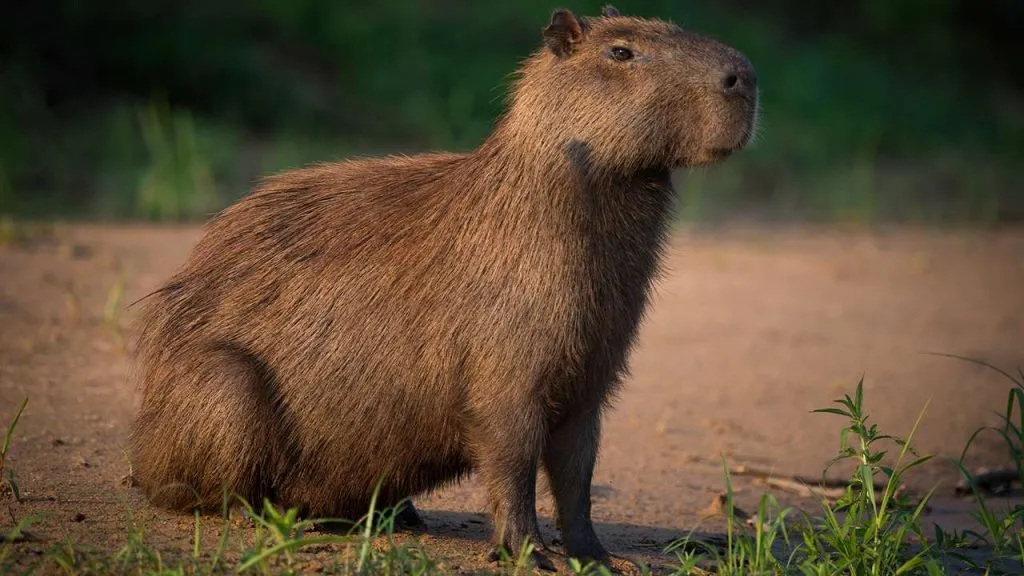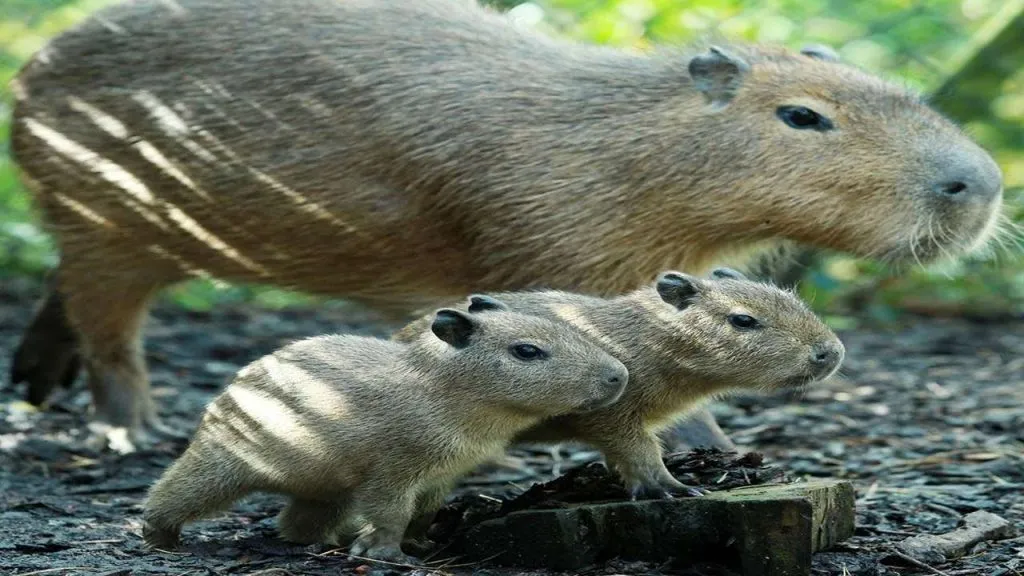As an Amazon Associate I earn from qualifying purchases.
Capybaras are the biggest rodents in the world, weighing up to 100 pounds (45 kilograms) and standing about 2 feet (60 centimeters) tall at their shoulders.
They live mostly in South America and are well-known for being friendly and eating plants.
Learning about what capybaras eat all year long helps us understand what they need to stay healthy and how they fit into their environments.
They’re lovely animals that can be great friends. But what exactly do capybaras eat?
In this blog post, we’ll talk about what capybaras like to eat, explore the different foods they enjoy, and share some interesting details about how they eat.
What Do Capybaras Eat All-Year Round: The Complete Diet of Capybaras

Capybaras, the biggest rodents around, mostly eat plants, so they’re plant-eaters, also known as herbivores.
Their food choices can change a bit depending on the time of year and what’s around them. All year long, capybaras snack on lots of different plant foods.
Grasses are a big part of their meals, especially in the rainy season when there’s plenty of fresh, green grass to munch on.
They like healthy grasses such as sedges, switchgrass, Bermudagrass, and crowngrass.
Capybaras love water and spend a lot of time near it. They like to nibble on waterlilies, reeds, and other watery plants.
Sometimes, they’ll even eat bark, fruits, roots, and crops like sugarcane and melons if they can’t find their usual food, especially when it’s dry outside.
They might also munch on some water plants they find in their homes, like water hyacinth and water lettuce.
It might sound a little weird, but capybaras eat their poop sometimes, especially in the morning.
This helps them get extra nutrients from their plant-based diet, especially the tough parts of plants that their stomach bacteria break down.
In the rainy season, when there’s lots of fresh grass and water plants, capybaras pick and choose the best food they can find.
But in the dry season, when food is scarce, they’ll eat things that aren’t as tasty, like less appealing plants, bark, and even crops.
Now that we’ve looked at what capybaras eat all year, let’s talk about what baby capybaras need to eat.
What Do Baby Capybaras Eat?
Baby capybaras, also called pups or cubs, begin drinking their mother’s milk soon after they’re born.
Capybara moms make milk that gives the babies all the important stuff they need to grow and get stronger.
As they get older, around one week after they’re born, the pups start to notice what the grown-ups are eating, especially soft grass and tender leaves.
They copy their moms and start nibbling on these foods, learning what’s good to eat and how to find it.
When they’re about 4 to 6 weeks old, the pups are munching on grass and other plants just like the adults.
They still drink milk from their mom but also enjoy solid foods. This goes on for about 16 weeks until they stop drinking milk and only eat plants.
Like adult capybaras, baby ones like tasty grass and tender plants. They’re not as picky as the grown-ups but they avoid tough plants that are hard to chew.
Once they start eating solid food, the pups also do something called cecotrophy, which means they eat their mom’s poop.
It might sound gross, but it helps them get extra nutrients and good bacteria for their tummies.
Each baby capybara might have its favorite foods and different ways of finding food.
It’s important to know that baby capybaras raised in captivity might need different kinds of food because their environment is different.
It’s a good idea to ask a vet or someone who knows a lot about capybaras for advice on how to take care of them and what to feed them.
What Are The Dietary Habits of Various Capybara Species?
Capybaras primarily share similar dietary habits across different species. As herbivores, their diet consists mainly of vegetation, which includes grasses, aquatic plants, reeds, and fruits.
However, specific dietary preferences and behaviors may vary slightly among different capybara species depending on their habitat and environmental factors.
For example:
1. Hydrochoerus hydrochaeris (Common Capybara): This is the most widely distributed and recognized species of capybara.
Common capybaras primarily feed on grasses and aquatic vegetation found in their habitats.
They may also consume fruits and other plant matter available in their surroundings.
2. Hydrochoerus isthmius (Greater Capybara): This species is native to Venezuela and parts of Colombia.
Greater capybaras likely have dietary habits similar to those of common capybaras, primarily feeding on grasses, aquatic plants, and fruits.
3. Hydrochoerus isthmius (Lesser Capybara): Found in the Amazon basin, lesser capybaras likely have similar dietary preferences to other capybara species, focusing on grasses, aquatic vegetation, and fruits.
How Does A Capybara Find Its Food?

Capybaras have many ways of finding food. They naturally like to look for food, spending lots of time grazing for plants like grass and those that grow in water.
They have really good smell and eyesight, so they can find these plants easily along riverbanks, marshes, and grassy areas where there’s plenty of food.
When it’s dry and there isn’t much to eat, they might nibble on leaves and bark from bushes and trees using their strong front teeth.
Capybaras are social animals, so they often look for food together in groups, learning from each other which plants are safe to eat and where to find them.
They also like to explore bodies of water, like rivers and ponds, to find water plants such as water lilies and reeds.
Capybaras rely on their senses, their friendships, and what they know about their environment to find and eat the plants they need to survive.
The Habitat of Capybara
Capybaras come from South America and live in lots of different places there.
They like wet areas like marshes and riverbanks because it’s easy for them to find water for swimming and looking for food.
They prefer places with lots of plants like grass, reeds, and plants that grow in water because these give them food to eat and places to hide from animals that might want to eat them.
They can live in different types of places, from rainforests to open grassy areas, as long as there’s water nearby.
Capybaras spend a lot of time near rivers, streams, lakes, and ponds, especially when it’s hot, so they can cool off by swimming.
Capybaras can adjust to living in many different environments, like forests, swamps, and even places where people grow crops, as long as there’s enough food and water.
They like being around other capybaras and often live in big groups, which can be small or big depending on how much food and space there is where they live.
Interesting Facts About The Capybaras
1. Semiaquatic Lifestyle: Capybaras are like water lovers.
They spend a lot of their time around water and are really good swimmers.
They can even stay underwater for a while to hide from predators.
2. Social Animals: They’re also big fans of hanging out with others.
They live in groups called herds, which can be small or big, with over 100 members sometimes.
They do lots of things together like grooming and resting.
3. Vocal Communicators: While they might not be chatterboxes, capybaras still communicate with each other using different sounds like purrs, barks, and whistles.
4. Masters of thermoregulation: Their lifestyle near water helps them control their body temperature, especially when it’s hot outside.
5. Diverse Diet: Even though they only eat plants, capybaras have a wide menu that includes grasses, water plants, fruits, and even some crops.
They also have a quirky habit of eating their poop to get extra nutrients from their food.
6. Cultural Significance: In some places like Venezuela and Colombia, capybaras have a special place in the culture and stories.
7. Important Ecosystem Role: Capybaras are essential in their ecosystems.
They help keep vegetation in check by munching on plants and also provide food for predators like jaguars and anacondas.
8. Domestication: In some places, people keep capybaras as pets or raise them for their meat and fur.
They’re known to be gentle and can get close to humans when raised in captivity.
These facts show how interesting and important capybaras are in nature and to people.
Conclusion
Capybaras are interesting animals that have a lot to offer.
They are social creatures that need plenty of space and attention, but they can make great pets for the right person.
If you’re thinking about getting a capybara, be sure to do your research first and make sure you have the time and resources to care for one properly.
Thanks for reading!
FAQ’s:
Capybaras eat quite a lot of food because they’re big animals.
On average, they can eat about 6 to 8 pounds (2.7 to 3.6 kilograms) of food every day.
This includes grasses, plants, and sometimes fruits. Since they’re herbivores, they munch on plants most of the time.
Capybaras usually live for around 8 to 10 years in the wild.
However, in captivity where they’re protected and well cared for, they can live even longer, sometimes up to 12 years or more.
Capybaras are semiaquatic animals, which means they spend a lot of time near water.
They get most of their water from the plants they eat, but they also drink water directly from rivers, lakes, ponds, and other water sources.
They need water to stay hydrated and cool, especially in hot weather.
Amazon and the Amazon logo are trademarks of Amazon.com, Inc, or its affiliates.

